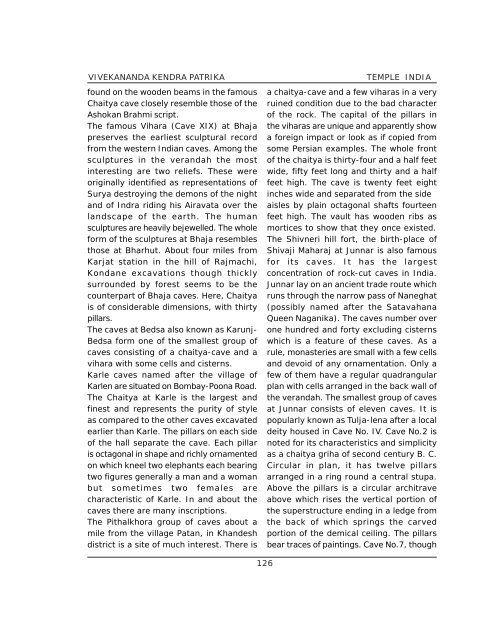Temples In India-1.pdf - Vivekananda Kendra Prakashan
Temples In India-1.pdf - Vivekananda Kendra Prakashan
Temples In India-1.pdf - Vivekananda Kendra Prakashan
Create successful ePaper yourself
Turn your PDF publications into a flip-book with our unique Google optimized e-Paper software.
VIVEKANANDA KENDRA PATRIKAfound on the wooden beams in the famousChaitya cave closely resemble those of theAshokan Brahmi script.The famous Vihara (Cave XIX) at Bhajapreserves the earliest sculptural recordfrom the western <strong>In</strong>dian caves. Among thesculptures in the verandah the mostinteresting are two reliefs. These wereoriginally identified as representations ofSurya destroying the demons of the nightand of <strong>In</strong>dra riding his Airavata over thelandscape of the earth. The humansculptures are heavily bejewelled. The wholeform of the sculptures at Bhaja resemblesthose at Bharhut. About four miles fromKarjat station in the hill of Rajmachi,Kondane excavations though thicklysurrounded by forest seems to be thecounterpart of Bhaja caves. Here, Chaityais of considerable dimensions, with thirtypillars.The caves at Bedsa also known as Karunj-Bedsa form one of the smallest group ofcaves consisting of a chaitya-cave and avihara with some cells and cisterns.Karle caves named after the village ofKarlen are situated on Bombay-Poona Road.The Chaitya at Karle is the largest andfinest and represents the purity of styleas compared to the other caves excavatedearlier than Karle. The pillars on each sideof the hall separate the cave. Each pillaris octagonal in shape and richly ornamentedon which kneel two elephants each bearingtwo figures generally a man and a womanbut sometimes two females arecharacteristic of Karle. <strong>In</strong> and about thecaves there are many inscriptions.The Pithalkhora group of caves about amile from the village Patan, in Khandeshdistrict is a site of much interest. There isTEMPLE INDIAa chaitya-cave and a few viharas in a veryruined condition due to the bad characterof the rock. The capital of the pillars inthe viharas are unique and apparently showa foreign impact or look as if copied fromsome Persian examples. The whole frontof the chaitya is thirty-four and a half feetwide, fifty feet long and thirty and a halffeet high. The cave is twenty feet eightinches wide and separated from the sideaisles by plain octagonal shafts fourteenfeet high. The vault has wooden ribs asmortices to show that they once existed.The Shivneri hill fort, the birth-place ofShivaji Maharaj at Junnar is also famousfor its caves. It has the largestconcentration of rock-cut caves in <strong>In</strong>dia.Junnar lay on an ancient trade route whichruns through the narrow pass of Naneghat(possibly named after the SatavahanaQueen Naganika). The caves number overone hundred and forty excluding cisternswhich is a feature of these caves. As arule, monasteries are small with a few cellsand devoid of any ornamentation. Only afew of them have a regular quadrangularplan with cells arranged in the back wall ofthe verandah. The smallest group of cavesat Junnar consists of eleven caves. It ispopularly known as Tulja-lena after a localdeity housed in Cave No. IV. Cave No.2 isnoted for its characteristics and simplicityas a chaitya griha of second century B. C.Circular in plan, it has twelve pillarsarranged in a ring round a central stupa.Above the pillars is a circular architraveabove which rises the vertical portion ofthe superstructure ending in a ledge fromthe back of which springs the carvedportion of the demical ceiling. The pillarsbear traces of paintings. Cave No.7, though126
















